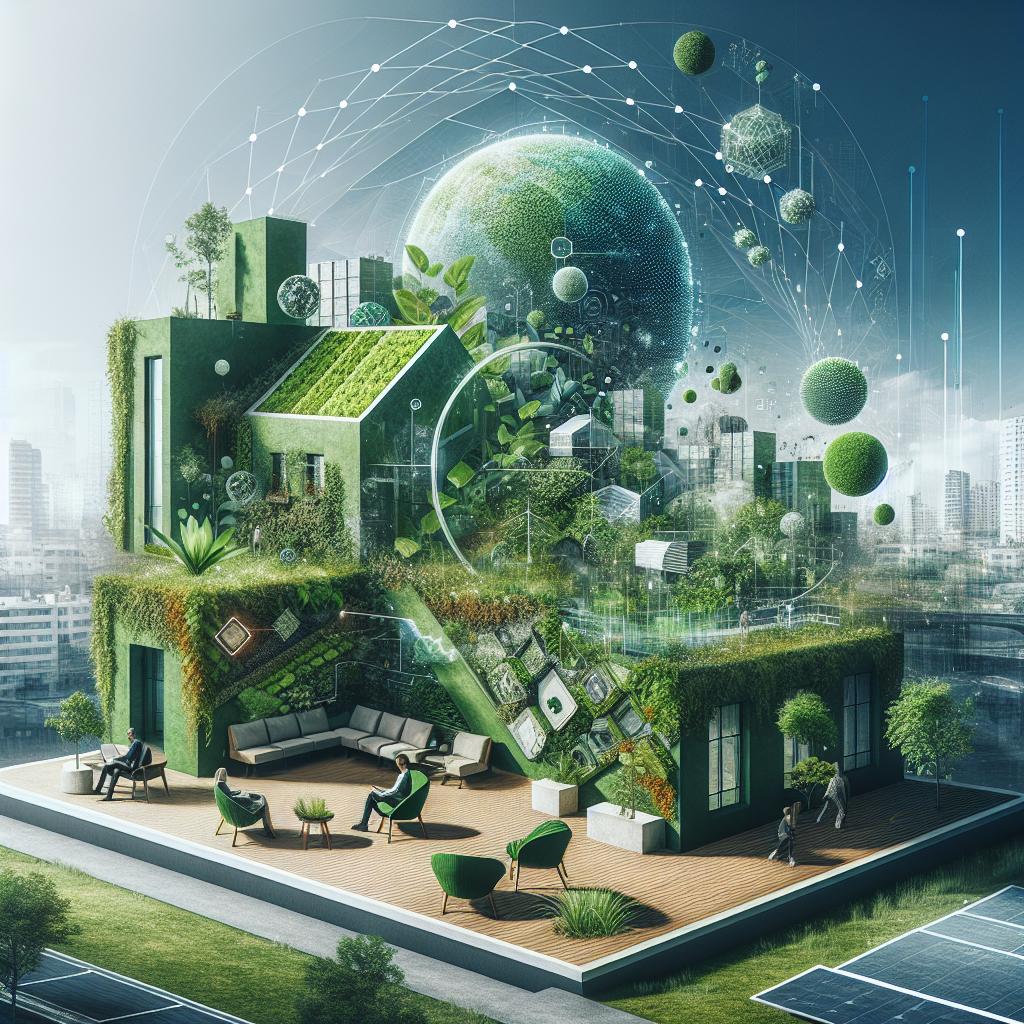As the sweltering heat of summer intensifies adn climate concerns become increasingly urgent, large commercial buildings are faced with a critical challenge: how to maintain comfort while minimizing environmental impact. Customary cooling systems, frequently enough energy-intensive and reliant on fossil fuels, contribute significantly to greenhouse gas emissions and rising energy costs.However, a shift towards eco-friendly cooling solutions is not just an aspiration; it is becoming a necessity.this article explores innovative technologies and practices designed to cool our urban landscapes sustainably. From advanced air conditioning systems that harness the power of renewable energy to design strategies that maximize natural ventilation, we will delve into a spectrum of options available for building managers and architects alike. Join us as we uncover the potential of these eco-friendly alternatives, paving the way for a cooler, greener future in commercial spaces.
Sustainable Technologies Shaping Commercial Cooling Systems
As businesses increasingly prioritize energy efficiency and environmental duty, innovative technologies are emerging to meet the cooling needs of large commercial buildings. Geothermal cooling systems, for instance, utilize the earth’s stable underground temperatures to regulate indoor climates, drastically reducing reliance on traditional energy sources. Solar-powered chillers offer another eco-friendly choice, harnessing solar energy to generate cooling, thereby minimizing carbon footprints. Additionally, the integration of smart thermostats and advanced building management systems enhances operational efficiency by optimizing cooling schedules based on real-time occupancy data.
Further advancements are being seen in the advancement of chilled beam systems, which utilize water to absorb heat, leading to notable reductions in energy consumption. To facilitate the transition towards greener technologies, many facilities are adopting phase-change materials (PCMs), enabling them to store and release thermal energy as needed, enhancing overall system performance. As businesses look to the future, investing in these sustainable technologies not only drives cost savings but also promotes a healthier surroundings. The chart below summarizes the key sustainable cooling technologies and their benefits:
| Technology | Benefits |
|---|---|
| Geothermal Systems | Reduces carbon footprint, energy-efficient |
| Solar-Powered chillers | Utilizes renewable energy, cost-effective |
| Chilled Beam Systems | Lower energy consumption, improved comfort |
| Phase-Change Materials | Enhances thermal performance, energy storage |

Exploring the Benefits of Green roofs and Living Walls
In recent years, green roofs and living walls have gained popularity as effective solutions for enhancing urban environments. These eco-friendly installations not only beautify the architecture but also contribute to improved energy efficiency. By acting as natural insulators, they provide a layer of protection against heat, reducing the need for artificial cooling systems. The benefits include:
- Temperature Regulation: Green roofs can lower surrounding air temperatures, creating more pleasant living spaces in commercial buildings.
- Air Quality Improvement: The vegetation absorbs pollutants and produces oxygen, which contributes to a healthier urban atmosphere.
- Stormwater Management: these systems help absorb rainwater,reducing runoff and the risk of flooding.
- Extended Roof Lifespan: By protecting roofing materials from UV exposure and extreme temperatures, green roofs can significantly prolong their durability.
Living walls, likewise, offer remarkable advantages that extend beyond aesthetics. They are imbued with the ability to improve indoor air quality while providing sound insulation, making them perfect for busy commercial hubs. Moreover, the combination of humidity regulation and visual appeal can enhance employee well-being and productivity. Below is a simple comparison highlighting the advantages of green roofs and living walls:
| Feature | Green Roofs | Living Walls |
|---|---|---|
| Energy Efficiency | ✔️ | ✔️ |
| Improves Air Quality | ✔️ | ✔️ |
| Noise Reduction | No | ✔️ |
| Space Requirements | Requires structural support | Can fit narrow spaces |

Innovative Water-Based Cooling Techniques for Energy Efficiency
In the quest for energy-efficient solutions, innovative water-based cooling techniques are rapidly gaining traction in the realm of large commercial buildings. These methods leverage the natural thermal properties of water to provide effective cooling while minimizing energy consumption. By utilizing systems such as chilled beams and evaporative cooling, businesses can significantly reduce their reliance on traditional air conditioning systems. Key benefits include:
- Lower energy bills due to reduced electricity usage
- Enhanced indoor air quality through improved humidity control
- Reduction in greenhouse gas emissions
Moreover, the integration of water-based systems allows for flexible design options that can complement existing infrastructures. Conducting regular maintenance and utilizing advanced monitoring systems can lead to optimized performance, further improving efficiency. A recent study highlighted the effectiveness of water-cooled chillers versus conventional options:
| Cooling System | Energy Efficiency Ratio (EER) | Annual Maintenance costs |
|---|---|---|
| Water-Cooled Chiller | 12.0 | $3,000 |
| Air-Cooled Chiller | 8.5 | $5,000 |
Transitioning to these advanced systems not only demonstrates a commitment to sustainability but also positions commercial buildings as leaders in energy efficiency. As these innovative technologies continue to evolve, the potential for further reducing operational costs while preserving the environment presents an exciting prospect for future developments.

Integrating Smart Technology for Optimized Climate Control
Incorporating smart technology into climate control systems allows large commercial buildings to achieve significant energy savings while enhancing comfort. Intelligent sensors can monitor indoor and outdoor temperatures,humidity levels,and occupancy patterns to adjust cooling systems automatically. By utilizing building management systems (BMS), property managers can facilitate real-time data access and implement strategies based on predictive analytics.This proactive approach empowers facilities to minimize energy consumption during peak hours and take advantage of lower electricity rates during off-peak times.
Moreover, integrating IoT (Internet of Things) devices ensures seamless communication between various components of the HVAC system.This connectivity allows for a more cohesive and responsive climate control environment. Key elements to consider include:
- Smart Thermostats: Automatically adjust based on occupancy and user preferences.
- Automated Window Shades: Optimize natural light and reduce heat gain.
- Zone Control systems: Enhance comfort by regulating temperature in different building areas.
By selecting energy-efficient technologies and automating climate control processes, businesses can not only lower operational costs but also contribute to sustainability goals. The following table summarizes the impact of smart integration:
| Technology | Impact on Energy Efficiency |
|---|---|
| Smart Sensors | Reduces unneeded cooling by adjusting to real-time conditions. |
| IoT Connectivity | Allows remote monitoring and management, enhancing responsiveness. |
| Automated Controls | Optimizes system performance based on usage patterns, cutting energy waste. |
Q&A
Q&A: Eco-friendly Cooling Solutions for large Commercial Buildings
Q1: What are eco-friendly cooling solutions, and why are they vital for large commercial buildings?
A1: Eco-friendly cooling solutions refer to sustainable methods and technologies designed to maintain comfortable indoor temperatures while minimizing energy consumption and environmental impact. For large commercial buildings, these solutions are crucial as they help reduce greenhouse gas emissions, lower utility costs, and enhance the building’s overall sustainability profile. By adopting such methods, buildings become more resilient to climate change while aligning with global sustainability goals.
Q2: Can you explain some of the most popular eco-friendly cooling technologies currently available?
A2: Certainly! Some popular eco-friendly cooling technologies include:
- chilled Beams: These systems use convection to cool spaces naturally, relying on cool water to absorb heat from the building’s air without the need for energy-intensive fans.
- Evaporative Cooling: Utilizing the natural process of water evaporation, these systems significantly lower temperatures with minimal energy use, especially effective in dry climates.
- Geothermal Cooling: By leveraging the stable temperatures underground, geothermal systems can provide efficient heating and cooling through the use of heat pumps.
- Variable Refrigerant Flow (VRF) Systems: These highly efficient systems allow for simultaneous heating and cooling in different parts of a building, adapting to varying occupancy levels.
Q3: How can large buildings integrate natural ventilation into their cooling strategies?
A3: Integrating natural ventilation involves designing spaces that promote airflow through strategically placed windows, vents, and architectural features like atriums or courtyards. This allows fresh air to circulate while expelling warm air. Additionally, buildings can implement automated systems that open and close windows based on temperature, reducing reliance on mechanical cooling and conserving energy.
Q4: What role does building orientation and design play in effective cooling?
A4: The orientation and design of a building significantly influence how it absorbs or repels heat. Positioning windows and other openings to take advantage of prevailing winds can enhance natural cooling. Moreover, using reflective or light-colored materials for roofs and walls can reduce heat absorption, while shading devices or green roofs can provide insulation and minimize cooling demands.
Q5: Are there any specific benefits associated with using eco-friendly cooling solutions?
A5: Absolutely! Some notable benefits include:
- Cost Savings: Reduced energy consumption translates to lower utility bills and operational costs.
- Enhanced Indoor Air Quality: Many eco-friendly systems improve indoor air circulation and reduce the presence of pollutants.
- Increased Comfort: These systems create stable and comfortable indoor environments that can heighten occupant satisfaction and productivity.
- Regulatory compliance: Many cities are implementing stricter building codes aimed at sustainability. Eco-friendly cooling solutions help businesses stay ahead of regulations.
Q6: How can businesses ensure they choose the right eco-friendly cooling solution for their specific needs?
A6: Businesses should begin by conducting a thorough energy audit to assess their current consumption and identify cooling needs. Consulting with HVAC professionals who specialize in eco-friendly solutions can provide valuable insights. Additionally, considering factors such as the building’s size, local climate, and budget will guide decision-making. It’s also beneficial to evaluate long-term sustainability goals and potential return on investment when selecting a cooling solution.
Q7: What can large commercial building owners do to encourage the adoption of eco-friendly cooling solutions in their industry?
A7: Building owners can lead by example by investing in eco-friendly technologies and showcasing their benefits through case studies and public engagements. Additionally, advocating for sustainable building practices within industry associations, participating in green building certification programs, and collaborating with local governments can definitely help drive broader adoption of eco-friendly strategies across the commercial sector.
This Q&A delves into the essence of eco-friendly cooling solutions,providing insight into their advantages and implementation strategies within large commercial buildings while fostering a commitment to sustainability.
To Conclude
As we navigate the challenges posed by climate change and rising energy costs, implementing eco-friendly cooling solutions in large commercial buildings emerges not just as an option, but as a necessity. The innovations explored in this article offer a glimpse into a future where sustainability and efficiency coexist harmoniously, allowing businesses to thrive without compromising the planet.
From geothermal systems that harness the earth’s natural cooling properties to smart technologies that optimize energy consumption, these strategies empower organizations to minimize their environmental footprint while enhancing occupant comfort. As we embrace a collective responsibility towards ecological stewardship, adopting these cooling solutions may very well pave the way for a greener, more sustainable tomorrow.
In an era where every decision counts, let us champion the cause of sustainable cooling, leading by example and inspiring others in our industry to follow suit. The road might potentially be challenging, but the benefits—lower operational costs, improved air quality, and a healthier environment—make it worthwhile. Together, we can create spaces that feel good and do good, setting a new standard for commercial buildings worldwide.

